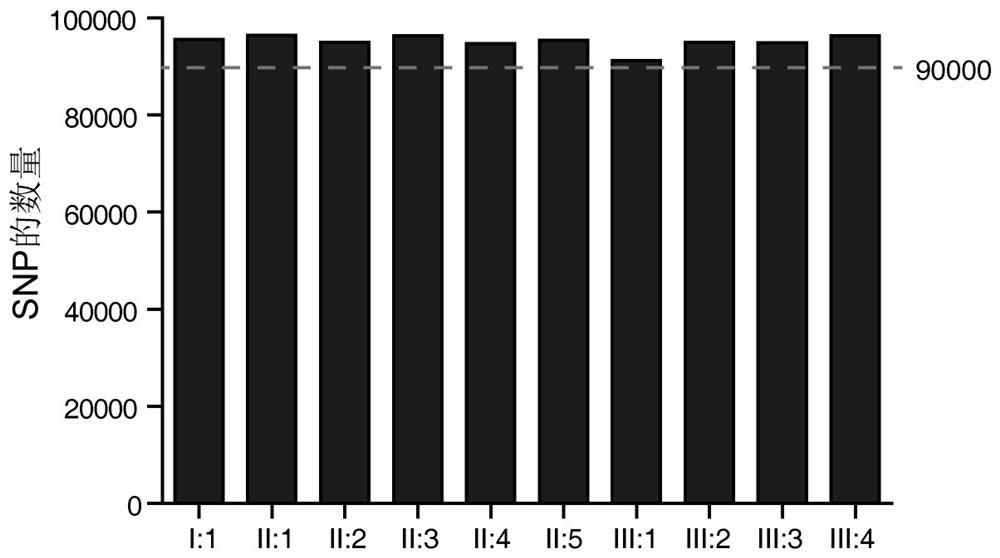Kits and applications for predicting and screening adolescent idiopathic scoliosis
A scoliosis, idiopathic technology, applied in the field of biomedicine, can solve the problem of unclear pathogenic factors of scoliosis, and achieve the effect of preventing rapid development
- Summary
- Abstract
- Description
- Claims
- Application Information
AI Technical Summary
Problems solved by technology
Method used
Image
Examples
Embodiment 1
[0111] Example 1 Analysis of AIS pathogenic genes
[0112] Blood samples were collected from AIS patients and other 3 AIS patients in their families, and DNA fragments were extracted. The specific steps are as follows:
[0113] (1) Take 400 μL of venous blood, add 1 mL of RCL to the blood sample, invert and mix several times, and place at room temperature for 5 minutes;
[0114] (2) Centrifuge at 10,000×g for 3 minutes, remove the supernatant, and leave the leukocyte pellet;
[0115] (3) Add 200 μL of B3 and 2 μl of Proteinase K, vortex and mix immediately, place at 65°C for 10 minutes, mix several times during this period, and the solution should become clear;
[0116] (4) Add 200 μL of isopropanol, invert and mix well, at this time, filamentous or clustered genomic DNA may appear;
[0117] (5) Centrifuge at 10000×g for 5 minutes, remove the supernatant;
[0118] (6) Add 200 μl of 70% ethanol, vortex for 5 seconds, centrifuge at 10,000×g for 5 minutes, remove the supernata...
Embodiment 2
[0123] Example 2 Analysis of the relationship between AIS-related mutation genes and muscle tissue morphology
[0124] According to the above-mentioned Example 1, there are 114 non-synonymous mutation SNPs in AIS patients. Since non-synonymous mutations may change the expressed amino acids, which may affect the function of the protein, 114 non-synonymous mutations in 86 AIS patients' shared genes were further selected for in-depth analysis.
[0125] Through GO classification and channel analysis of 86 genes shared by AIS patients, it was found that the most abundant category of these genes in biological processes is cellular processes, cells, cell parts, and organelles represent the main proportion of cellular components, and combinations account for a large proportion of molecular functions. large part (see Image 6 ). Pathway analysis showed that shared genes were mainly enriched in 10 pathways, including inflammatory signaling pathway, regulation of cytoskeleton by Rho GT...
Embodiment 3
[0126] Example 3 Analysis of the relationship between TTN mutation and the pathogenesis of AIS
[0127] The number of base mutations in the patient's AIS shared gene was analyzed in Example 1, and the results were as follows Figure 9-10 shown. The results showed that most AIS-associated mutant genes had only 1 SNP, but TTN had 14 non-synonymous SNPs (see Figure 9 ). The distribution of these 14 mutants in the TTN protein is as follows Figure 10 shown. Since the TTN gene encodes titin, the largest known protein that is closely related to muscle development, it is an excellent candidate gene for AIS.
[0128] Subsequently, in order to clarify whether there is a correlation between the TTN mutation and the onset of AIS, the sample size of the experiment was further expanded, and TTN sequencing was performed on 140 AIS patients and 121 normal subjects. Firstly, 13 pairs of primers were designed according to the mutation sites of TTN, in which the first pair of primers cont...
PUM
 Login to View More
Login to View More Abstract
Description
Claims
Application Information
 Login to View More
Login to View More - R&D
- Intellectual Property
- Life Sciences
- Materials
- Tech Scout
- Unparalleled Data Quality
- Higher Quality Content
- 60% Fewer Hallucinations
Browse by: Latest US Patents, China's latest patents, Technical Efficacy Thesaurus, Application Domain, Technology Topic, Popular Technical Reports.
© 2025 PatSnap. All rights reserved.Legal|Privacy policy|Modern Slavery Act Transparency Statement|Sitemap|About US| Contact US: help@patsnap.com



